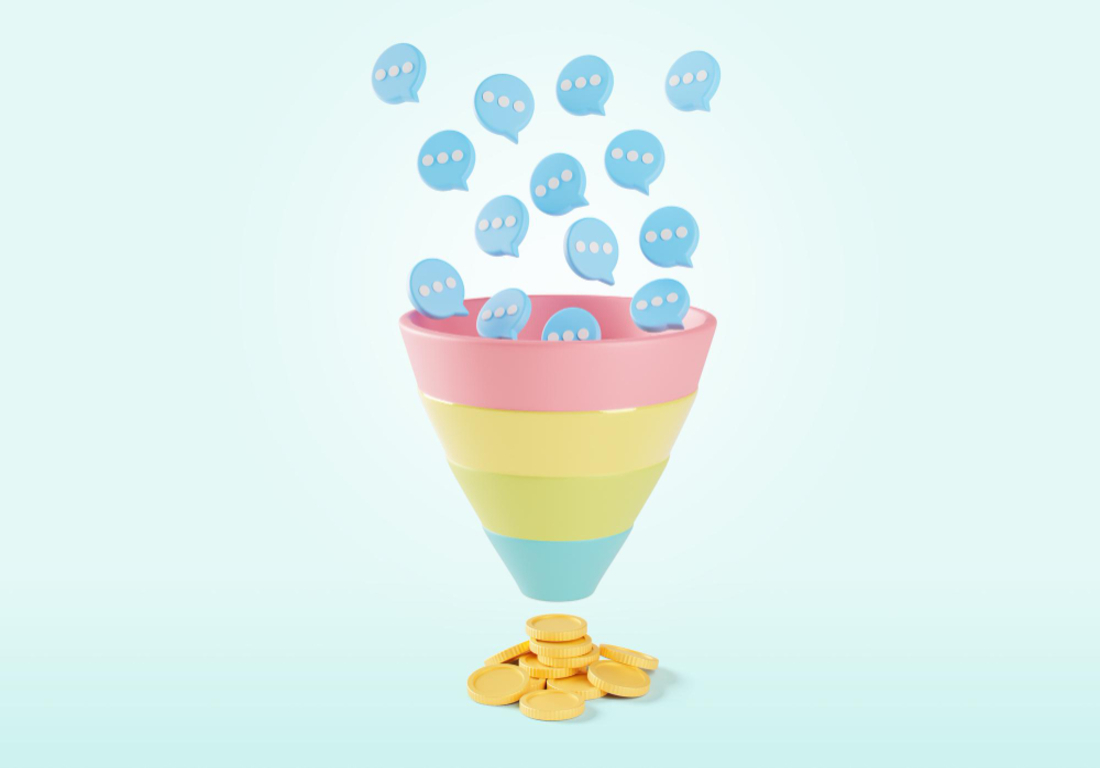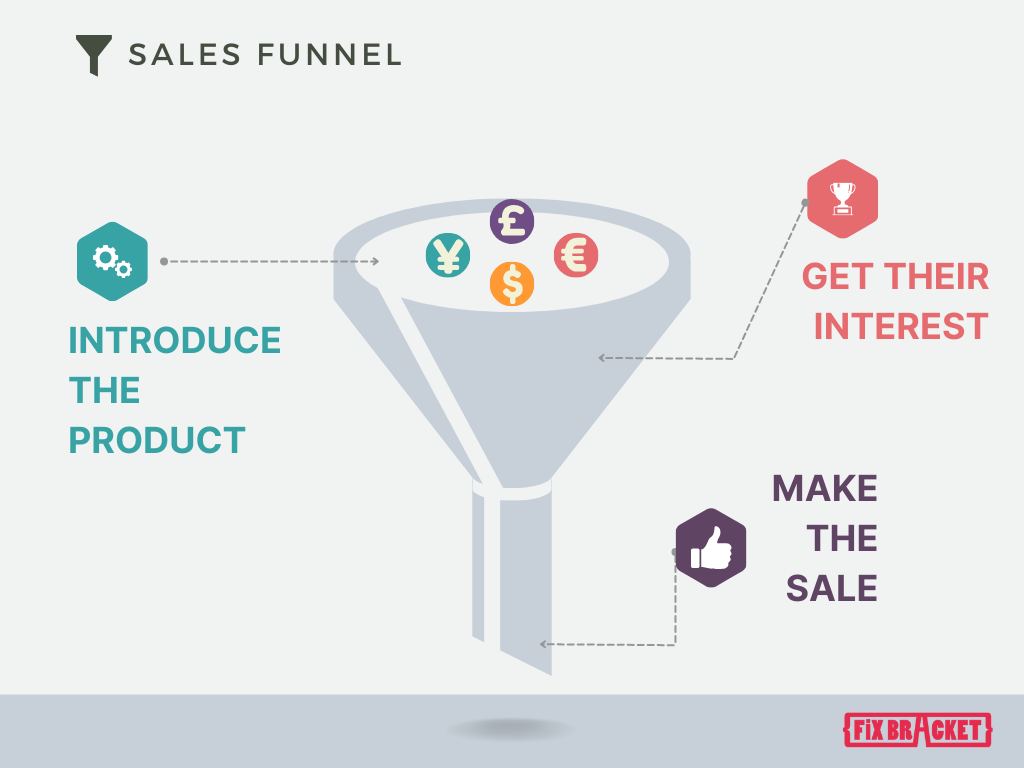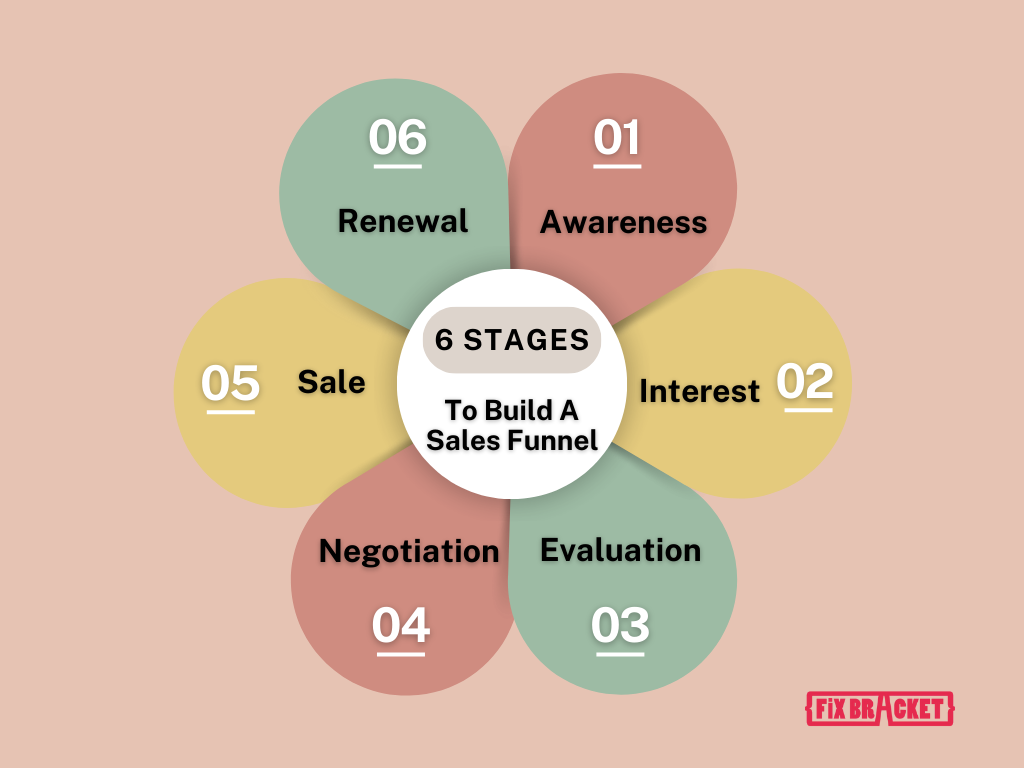
When you’re at a bustling market, you stroll past vendors, eyeing their products, and suddenly find yourself drawn toward a stall. That journey, from catching your eye to making a purchase, mirrors what we call a sales funnel in marketing.
In this article, we’ll learn about what a sales funnel is, why it’s important, and the steps marketing teams can follow to build their own sales funnel.
What’s A Sales Funnel?
A sales funnel is like a roadmap from window shopping to making a purchase. Just as a funnel narrows down from top to bottom, many people might show interest initially, but only a few end up buying.
It’s a step-by-step process: first, people learn about a product (top of the funnel), then they get interested (middle), and finally, they’re ready to buy (bottom).

The Three Major Parts Of A Sales Funnel
Understanding this process helps companies lead customers through each step, providing the right info and incentives to encourage purchases. Ultimately, it’s about turning curiosity into sales by shepherding potential buyers through the process.
Why Is It Important?
Imagine you’re hosting a grand event and you want to guide guests from the entrance to the main stage. That’s pretty much what a sales funnel does in the world of business—it’s your guide to understanding how customers move from being curious to making a purchase.
The magic of a sales funnel lies in its ability to map out this journey. It’s like having a GPS for your marketing efforts, showing you where your potential customers are and how to lead them toward making a buy.
Think of it this way: a sales funnel is like a filter that sifts through a big crowd, narrowing down to those who are genuinely interested.
Understand with an example
For instance, in online shopping, a visitor to an e-commerce site could be anyone just checking things out. But when they sign up for the newsletter, they move a step closer—they become a lead. Then come the engaging emails or messages, nudging them back to the site and turning them into prospects. And finally, with the right incentive or offer, they become a customer.
Now, this journey varies for every business. Whether you’re selling gadgets or grooming products, the steps might differ, but the essence remains the same: guiding people smoothly from ‘interested’ to ‘purchased’.
Understanding this process helps businesses tailor their strategies. It’s about reaching out through the right channels, offering the right deals, and saying the right things to turn that interest into a sale.
Just like guiding guests at an event, a well-structured sales funnel ensures potential customers find their way to making a purchase.
Why Do You Need A Funnel For Sales?
A sales funnel offers several advantages in steering leads toward becoming paying customers. Here are six benefits:
- Focused Strategy: A sales funnel aligns sales and marketing efforts, delivering relevant information to prospects regardless of direct sales interactions.
- Tailored Messaging: Recognizing customer journey stages enables targeted content—like introductory materials for newcomers and detailed product information for those familiar with the brand.
- Efficient Content Creation: A well-structured funnel streamlines content creation by crafting material suited for each stage, saving time and effort in dissemination.
- Increased Sales Potential: Optimized funnels nurture leads, potentially increasing sales by 50% compared to neglected leads, ensuring enthusiastic buying readiness.
- Predictive Insights: Sales funnels aid in revenue forecasting by using conversion rates and estimated deal sizes to project future sales based on prospects in the pipeline.
What Are The 6 Stages In A Sales Funnel?
Not all sales funnels are the same—they vary in size and shape depending on the company and industry.
While a basic sales funnel often has six stages, it’s important to know that this structure isn’t universal. Marketers can use this simple model as a starting point to create a sales funnel that fits their organization’s needs.

Awareness: This stage marks the initial encounter with your brand. People here are just becoming familiar with your company, products, or services. They’ve had their first interactions but aren’t yet prospects. They might have stumbled upon your website, social media, or ads, sparking their awareness of your existence.
Interest: Among those who’ve become aware, some have started showing genuine interest. They’re exploring further, diving into your offerings, browsing through your website, checking out your content (such as blogs, videos, or resources), and perhaps reading reviews or testimonials. Their curiosity pushes them deeper into understanding what your brand offers and its value.
Evaluation: As their interest grows, prospects delve deeper into researching your brand. They’re seeking more specific information. They might engage by asking questions, reaching out to customer service, or filling out forms to access additional details. At this stage, they’re likely comparing your offerings with your competitors’, trying to find the best solution to meet their needs or solve their problems.
Negotiation & Decision: This stage marks a critical point where prospects are very close to making a decision. They’ve gathered substantial information and are considering a purchase. They might engage in negotiations, discussing terms, pricing, or specific features. Their intention to buy is evident, and they’re ironing out the final details before committing.
Sale: This is the conversion stage. The prospect has decided to move forward and officially become a customer. Negotiations are settled, terms are agreed upon, and the transaction takes place, whether it’s a product purchase, service agreement, or subscription.
Renewal or Repurchase: Beyond the initial sale, some products or services involve ongoing relationships. Customers might reach the end of a contract or subscription. At this stage, they must decide whether to renew their agreement with your company or make a new purchase. There could be discussions about terms, price adjustments, or added features to continue the relationship.
How Do You Build A Sales Funnel?
Creating a sales funnel involves various approaches, with different types tailored to specific businesses and industries. However, certain fundamental elements are common across most sales funnels.
Follow these steps to construct a sales funnel for your business:
1. Gather Data and Understand Your Customers: The key to an effective sales funnel lies in understanding your audience through direct communication. Focusing on those who align well with your offerings helps tailor the funnel to highlight pertinent selling points and gain insights for product/service enhancement.
2. Capture Your Audience’s Attention: Drawing prospects into your funnel is essential. Engage an agency well-versed in content marketing or SEO to diversify content across platforms and attract organic traffic. Utilize varied content forms such as infographics, videos, and social media content to engage different traffic sources.
3.Build a Landing Page: Despite being less favored, landing pages boast a high conversion rate. These pages serve as a crucial link for prospects from ads or content to your offerings. A compelling landing page with a clear value proposition, a form for information capture, and a bold call to action is pivotal.
4. Offer Something Valuable: Encourage action from prospects by providing incentives like discounts or gated content. Time-limited offers with a sense of urgency can significantly boost sales.
5. Nurture the Prospect: Nurturing begins at the top of the funnel (Awareness and Interest stages). Provide meaningful content—like guides, eBooks, and surveys—that aids prospects in understanding your brand and offerings. Engage customer support to guide prospects on maximizing product benefits.
6. Create an Email Drip Campaign: After capturing leads, communicate through email marketing. Educate prospects with valuable content before introducing sales-oriented information. End the campaign with a compelling offer to prompt action.
7. Keep the Communication Going: Post-purchase, maintain communication with customers. Offer educational content, and regular updates, and engage them in your social media strategies to build trust and loyalty.
8. Upsell, Cross-Sell, and Downsell: Offer additional products to existing customers, cross-sell complementary items, or modify offers to suit hesitant prospects.
9. Optimize Your Sales Funnel: Optimization is critical for maximum conversions:
10. Audience Research: Create buyer personas based on extensive audience research for targeted outreach.
11. Set Measurable Goals: Establish measurable goals using tools like Google Analytics and invest in CRM tools for accurate sales forecasting.
12. Analyze and Test Landing Pages: Conduct A/B testing, optimize page loading speeds, and ensure engaging content.
13. Active Social Media Presence: Leverage social media for brand awareness, traffic, and sales opportunities.
14. Utilize Social Proof: Feature positive testimonials and reviews on websites to build trust and credibility.
15. Strong CTAs: Use bold, visually appealing call-to-action buttons strategically across content for conversions.
These optimization strategies aim to refine the sales funnel continually, ensuring enhanced conversions and customer trust.
Conclusion
Successful sales funnels hinge on understanding your audience, engaging them strategically, and constantly fine-tuning.
It starts by knowing your customers well, using diverse content to attract attention, and offering value to draw prospects in. Nurturing prospects, ongoing communication, and post-sale engagement build lasting relationships.
Optimization is crucial.
Research, measurable goals, testing landing pages, active social media presence, social proof, and strong CTAs continually refine the funnel. It’s not just about sales; it’s about fostering trust and loyalty. A well-optimized sales funnel creates a symbiotic relationship between your business and customers, benefitting both parties.




